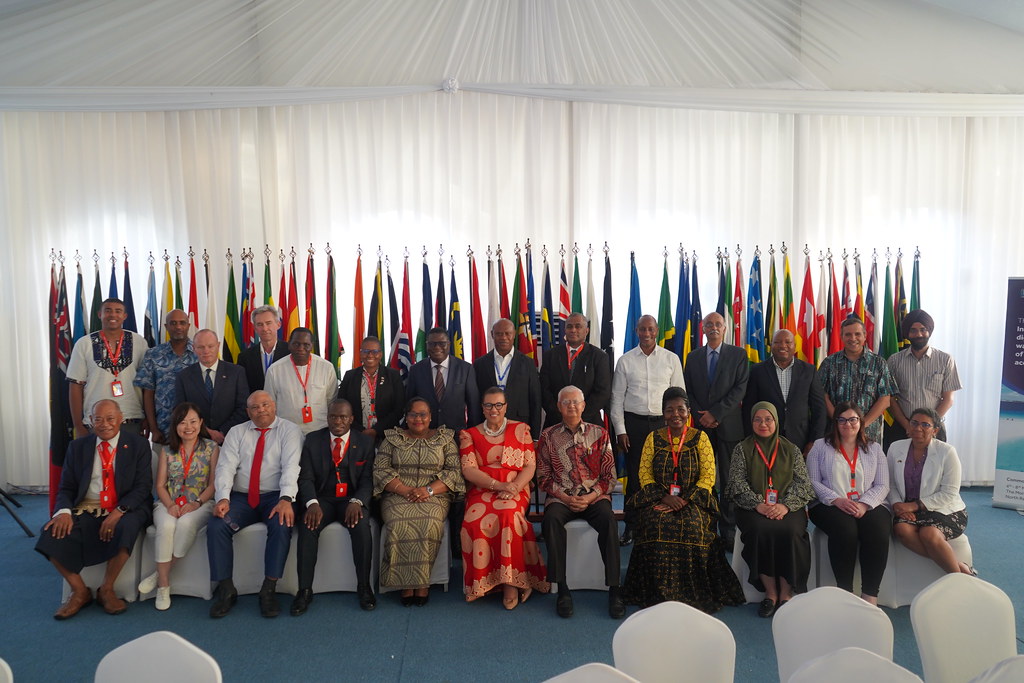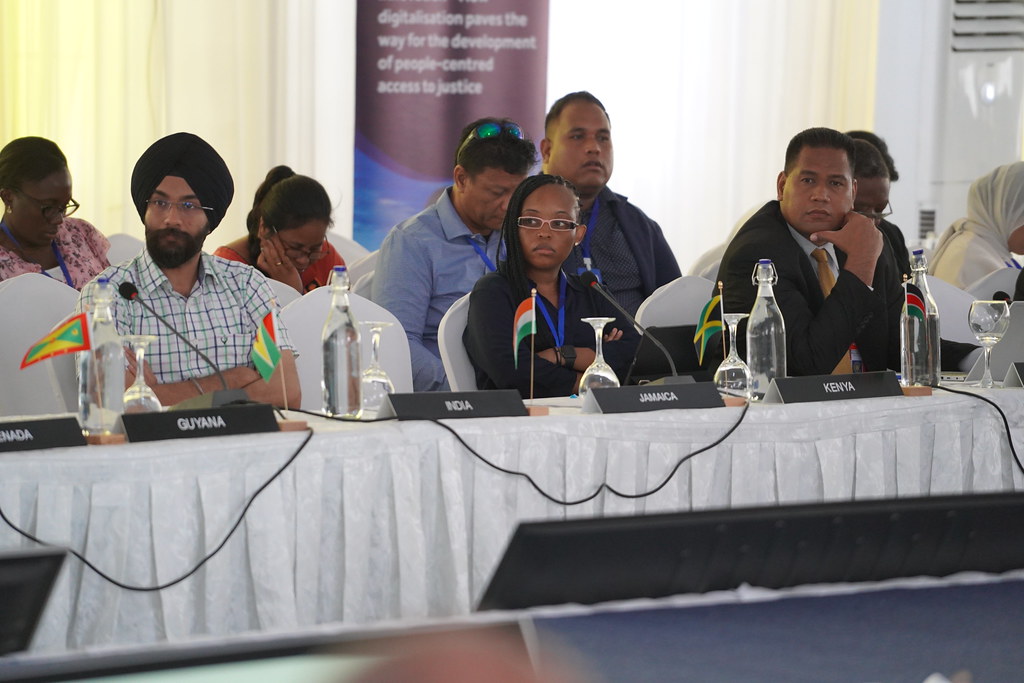By Theresa Smout and Sam Muller
“If 50% of our citizens did not receive health from the health system, we would speak of a state of emergency. With 50% of our citizens having unresolved or only partially resolved justice problems, we should also speak of a state of emergency in our justice systems,” concluded one of the ministers at the 2024 Commonwealth Law Ministers Meeting, held early March.
The authors had the privilege of engaging ministers in an exchange on people-centred justice programming to tackle the 50% Justice Challenge. The size of the challenge was not questioned. There was a general sense that the response should be people-centred: justice mechanisms that are close to where people live and work – responsive, simple, and fast. The key challenges are how to scale, how to sustainably fund, and how to deliver quality services. What is now needed is leadership.

Coming together
The Commonwealth Law Ministers have recurrently prioritised addressing the justice gap – it was on the agenda during its meetings in Colombo (2019), Mauritius (2022), and Zanzibar (2024), as well as at the Heads of Government Meeting in Kigali in 2022.
Consistently, there has been unequivocal recognition that a justice gap exists. How wide that gap is, differs from country to country, but ministers coalesced around the people-centred justice approach as a way to close it. The approach is now also captured in an OECD recommendation. A coalition of more than 18 States and partner organisations, called the Justice Action Coalition, has also been formed to support this way of working at the international level.
The theme of the meeting ‘Technology and Innovation: How digitalisation paves the way for the development of people-centred access to justice’ initially had us worried. Digitising the current systems is digitising the status quo, which will not close the 50% gap. However, both the ministers’ analysis of the problem and the direction for change they set are not about more of the same. There is a real opportunity — it now needs to be taken.
Starting with a concrete example
The Judiciary of Kenya is probably the furthest ahead in terms of having a concrete plan for the 50% Justice Challenge. It was presented to the nation in November, last year: the Social Transformation through Access to Justice Blueprint. The Judiciary’s formidable leader, the Honourable Chief Justice Martha Koome, provided law ministers with an overview of the Blueprint during the meeting. Its goal is audacious: “20 million Kenyans excluded from the formal justice sector will have access to an efficient and responsive justice system that is inclusive and utilises people’s justice capabilities by 2033”.
The approach is people-centred and the multi-door justice responses put forward are innovative. The value of an open conversation between a representative from the judiciary and representatives from the executive branch also emerged. One of the ministers present explicitly stated that such conversations don’t happen a lot, even though they are essential for formulating responses to the Justice Challenge.
The gap is not questioned—the real issue is how to close it
The widely available data measuring the justice gap was not questioned. There was an unequivocal recognition of the existence of the 50% Justice Challenge. The urgency and opportunity of tackling it was not questioned, inside and outside the Commonwealth orbit. The Rt Hon Patricia Scotland KC worded it forcefully when she said that adequate measures were “absolutely critical” and a “powerful new consensus” allows ministers and chief justices to move forward.
Ministries of justice and judiciaries are overstretched and there is not enough budget to support current commitments, let alone for starting something new. Managing the transition to outcomes without disrupting the delivery of justice services will be an important part of securing wider buy-in.
“Digitising the current systems is digitising the status quo, which will not close the 50% gap.”
The separation of powers poses considerable challenges for productive and frank conversations between, for example, the executive and the judiciary. Separation of powers is critically important, but at the same time, the justice gap will not be closed if the participants remain siloed.
There are conflicting power interests to consider. The legal profession is also a powerful actor, which generally puts its full weight behind one way of getting justice to people: lawyers. But, as said before, other delivery models are also needed, and these do not require mainly lawyers to run them. The legal profession can be a huge hindrance to change. How to deal with this?
Changing a justice system also carries considerable political risk. How can that risk be managed, in addition to all the other risks ministers of justice or attorney generals manage? It is not a secure job generally; and with limited budgets, they must choose their battles. Then there is the challenge of corruption. A shift to a new approach requires old habits, mindsets, and ways of working to be left behind. As one minister put it, to earn the trust of people, integrity is needed more than ever. How can this risk be managed and integrity be established in practice?
“Three common challenges emerged when we listened to these different examples of other delivery models.“
Another participant asked: for which things do you need a lawyer and what can you do without them? Indeed, a large part of the 50% Justice Challenge does not require a response from lawyers. More courts and law firms are not the answer. Other justice delivery models have been emerging for a while and are becoming more mainstream. Different forms of community justice. Mediation. ADR. Ward tribunals. Abunzi courts. Small claims courts. Tribal courts. Legal aid and paralegals. The National Legal Services Authority. They have a few things in common.
A minister said it well: they meet people and communities where they are, they help people move on, and they are accessible and easy to use. This means they must be inclusive, embrace diversity and evolve with the complexities of today’s world. Most countries are multi-ethnic and have many traditions, cultures, and languages. The impact and understanding of justice mechanisms is different in each community. Reaching people where they are can be hard. Building inclusive responses is already happening but requires equal attention to removing wider educational, income and social inequalities.
Three common challenges emerged when we listened to these different examples of other delivery models. Firstly, the challenge of scale. The Abunzi courts of Rwanda and the National Legal Services Authority in India are two examples that scaled nationally. But getting there is not a given. These alternative mechanisms could be better connected with the national system.
Secondly, the challenge of providing a quality service; its delivery, and its operation. Setting up and running such mechanisms requires knowledge. How can the various types of legal problems be resolved in a fair and just manner? Specialised knowledge is needed for data collection, shifting to a more evidence-based way of working, developing new delivery models, new regulatory models, new financing models, and more. How to support them with good IT systems and other operational infrastructure? This also includes the need for some measure of quality control: it is important that these mechanisms comply, for example, with basic human rights.
The third big challenge is that of sustainable funding. Most of the initiatives struggle to get by and are largely dependent on the whims of donors and philanthropy.
Rethinking the 50 % justice challenge
What if the 50% Justice Challenge could be met in a way that is doable and manageable, both in terms of political risk and delivery? In a way that does not require millions in new funding but focuses instead on using existing funds in a better way? In a way that also transforms the justice system and strengthens ministries of justice and judiciaries, making them less overburdened? What if the necessary capacity could be sustainably created? Knowledge of what works could be found, integrated and further developed, both within the ministry and with partners?
And doing all this would also be good for the economy and make a significant contribution to stability, social cohesion, inclusion, safety, and better governance.
This, we learned from all the conversations, is possible. Solution thinking is clearly pointing in the direction of better justice responses that meet people and communities where they are, help people move on, and that are accessible and easy to use. It takes visionary, focussed, and shared leadership to make it happen.
Visionary leadership sets an ambitious people-centred target: recognising the 50% Justice Challenge and defining an ambitious response. The Social Transformation through Access to Justice Blueprint gives an inspiring example by making a clear promise to 20 million Kenyans and charting a course to keep that promise.
Focussed leadership starts with data, sets priorities, develops outcome-based goals, and builds a monitoring system to measure progress and outcomes achieved. It works on the basis of evidence-based best practices and constantly improves and innovates where needed. Interventions that work best to resolve the most frequent and pressing problems people have are scaled, one by one. An enabling environment for this is maintained so these interventions can sustainably continue.
Shared leadership thinks about a justice system as an ecosystem. It is inclusive and builds on the strengths of many to thrive. It continuously updates and evolves to a changing environment. It leaves no one behind. This needs ongoing conversations, including across the separation of powers; but more than ever, it needs the contributions of all justice system actors.
The challenge is clear. Elements of the way forward were visible in the room. The approach to take. The investment that is needed in terms of knowledge and capacity—both nationally and internationally. And what leaders like ministers and chief justices can do.
We urge them to do it—and offer our support where deemed useful.


